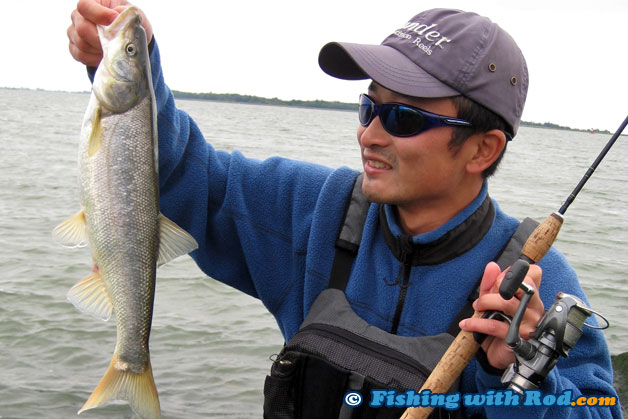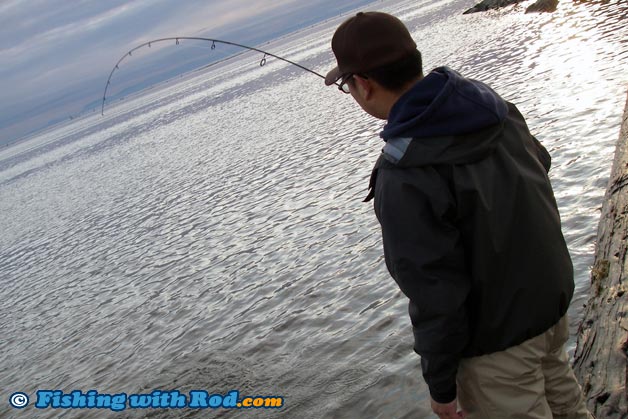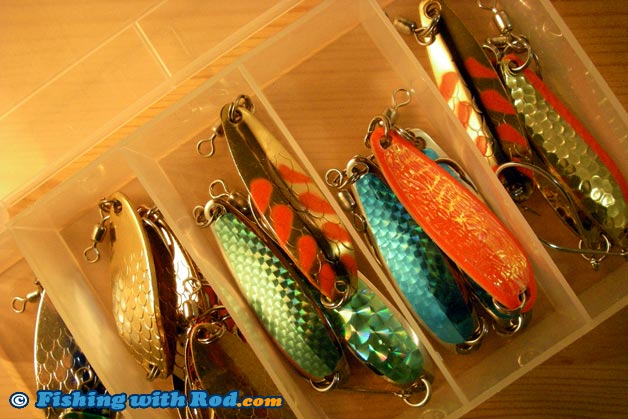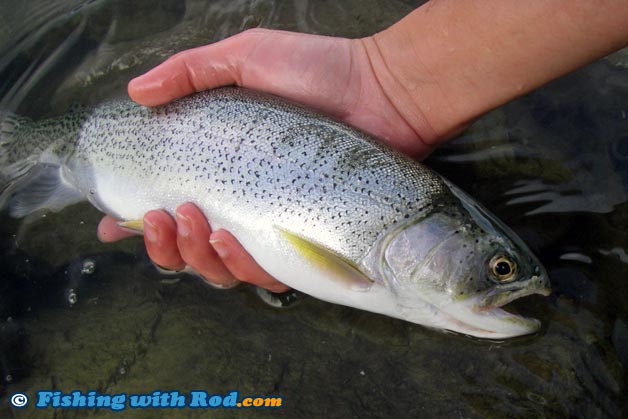Tidal Fraser River Light Spincasting
By Rodney Hsu, Fishing with Rod | Published in February 2009

Stretching from Vancouver to Prince George, Fraser River is comonly known as a giant corridor for migratory salmon and other anadromous species throughout the year. Its primary target sportfish species are pacific salmon. In September and October, one can often find enthusiastic anglers lining along the shoreline in the tidal portion of the Fraser River, hoping to connect with a pink, coho or chum salmon.
It is a sharp contrast to the rest of the year, when adult salmon are absent during the incoming tide and the sighting of an angler is rare. This does not indicate that the water is void of fish, it is in fact quite the opposite. Beside migratory salmon, which only temporarily utilize the waterway between Mission and Steveston, dozens of fish species inhabit it year-round.
They belong in all trophic levels, from miniature sculpin to prehistoric white sturgeon. Chucking a baited hook in the water would most likely trigger a bite during anytime of the year, but it is not satisfactory for anglers who prefer fishing with artificial lures. Three predatory species exist in these waters and can easily be caught on hardware year-round, yet they are constantly overlooked.
The first northern pikeminnow that I caught was on a baited hook while fishing for peamouth chub. After learning more about their behaviour, it only makes sense that they would not hesitate to grab a lure. Bull trout and cutthroat trout are known as small by-catches while spincasting or bait fishing for salmon, but heavy tackle does not do their fight justice.
Their weight class ranges from one to six pounds, making them good candidates in a light spincasting fishery. It is simple because the required tackle is minimal. It is convenient because the fishing spots are a short drive from Metro Vancouver. It is fun because there is not a shortage of aggressive fish.
Required Tackle for Light Spincasting

Matching fishing tackle to the size and strength of your target species is important. Hauling in a trout or minnow with a salmon rod is not so logical. The job is better accomplished with a light spincasting setup, which delivers a pleasant experience when fished with. An angler can produce hundeds of casts without ending up with a sore shoulder or back. The bites are more easily detected and the fight is much harder yet controlled.
I prefer to use a spinning rod that is not longer than 6 feet, so it does not constrict my mobility. When purchasing, it is important to pay close attention to the line rating, lure weight range and action of the rod. All reputable brands produce light spinning rods that have a line rating of 2 to 6lb test and are capable of casting lures up to 1/4oz. A small spinning reel balances a light spinning rod well, but also provides the correct spool capacity for 2 to 6lb test line. This setup is primarily designed for small trout in lakes and creeks, but perfectly suitable for the Tidal Fraser River light spincasting fishery.
Terminal tackle required in this technique is minimal. A box filled with spoons and spinners is your ticket to a fun fishing outing. Lures that are commonly productive include Gibbs' Croc and Koho. Small spinners can easily be made with blades, bodies and beads, which are readily available at tacklestores. Catching fish on homemade lures brings more joy than using store-bought lures. Lure sizes and colours vary based on water conditions. All colours would produce fish, but water clarity may alter catch results. It is best to experiment and document the results in a fishing journal for future references. 1/8oz and 1/4oz are the best lure weights, but larger spoons tend to produce more bull trout while the chance of catching a cutthroat trout is bigger with smaller spinners.

With these items in hands, you are ready to fish! Other additional accessories, such as waders, a landing net, a hook sharpener and a pair of pliers are not necessary but good to have. Because it is primarily a catch and release fishery, carrying a point and shoot camera is also a great idea to document your catches.
Seasons and Timing

While fish can be encountered throughout the year in the Tidal Fraser River, certain months are more productive than others. Bull trout and cutthroat trout are highly migratory and opportunitistic predators. Their populations tend to concentrate in May, June, October and November.
During May and June, the down-migration of juvenile salmon and spawning of eulachon create a feeding frenzy. The water clarity maybe poor due to freshet, but a spinner with a large blade should have no problem attracting them. They often disappear in the summer and re-appear in October and November, when adult salmon migrate into the Fraser.
The presence of northern pikeminnow is quite the opposite to trout and char. Large northern pikeminnow become active in August when freshet recedes and remain abundant until early October.
Although fish are hard to come by between December and April, hunting for overwintering bull trout in the Tidal Fraser River can be just as exciting. The water tends to be clearer, due to the low freezing level and higher percentage of saltwater in the water column. Quite often the lure take can actually be seen in the clear water. Bites are rare, but fish are mostly solid and strong.
Because this section of the Fraser River is influenced by tides, timing is the decisive factor. Fishing two hours before and after flood tides is a safe bet, because their food items are always on the move during that period. Flood tides also bring in more saltwater, resulting in clearer water, which is an advantage for lure anglers.
Techniques and Locations
Spincasting artificials is as easy as casting and retrieving repeatedly, but some modifications can improve results overtime. Reel and pause, quick jerks during spinning and adjusting retrieving speeds are techniques that can trigger a bite from a skeptical fish. Pointing the rod tip toward the water gives the lure a better swim action, as well as providing more space for the angler to set the hook when needed.

Swirls on the surface are common in spring when fish feed heavily on the surface, but these predatory fish do not show themselves majority of the time. With the water visibility sitting at one to three feet, it is difficult to know where to cast. That being said, numerous visual cues can aid you to productive outings. A visit to the same fishing spot during low tide allows anglers to mark out structures and riverbed contours. Bays and backwaters where tidal current does not exist are preferred habitat for predatory fish. Submerged mud flats are often inhabited by sculpin, which is a favorite food item for both trout and char. Look for schools of juvenile salmon and other baitfish moving by in the shallow water. These can attract a feeding frenzy without any warning.
When retrieving your lure, be sure to keep it in the water until it reaches the rod tip. Both bull trout and northern pikeminnow would often follow it for a long time before striking, while other times they dart from the shallow water and strike near the surface. Misses usually occur when the angler does not pay attention to the lure, so it is important to keep an eye on it as it approaches you. Simultaneously sighting and detecting a strike can raise an angler's heart beat instantly.
Conservation and Ethics

Bull trout and cutthroat trout populations in the Fraser River are considered vulnerable. Their abundance was almost eradicated due to overfishing in the past, but recovery efforts have resulted in sustainable catch and release opportunities. Wild bull trout and cutthroat trout are required to be released, while hatchery raised cutthroat trout can be retained (marked by the absence of their adipose fin, please check the latest fishing regulations for daily quota).
The objective of catching and releasing fish is to enjoy a sportfishery while ensuring its sustainability. To practice it properly, anglers should keep their catch in the water as much as possible. A soft mesh landing net is handy when fishing from rocks, while waders allow the angler to walk on submerged mud flats so fish can be handled in the safest manner.
With your assistance, hopefully the populations of these fantastic gamefish will thrive once again.

